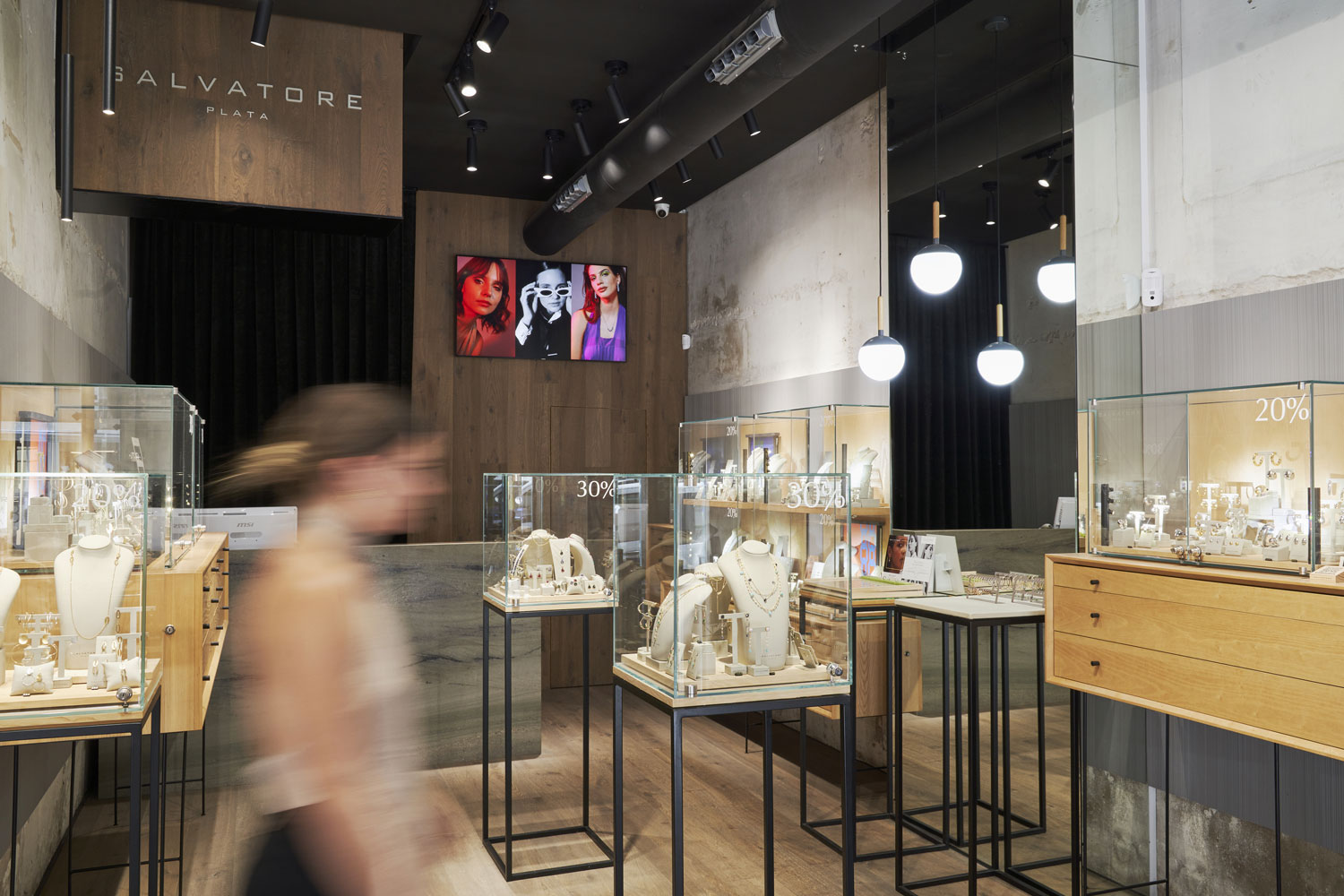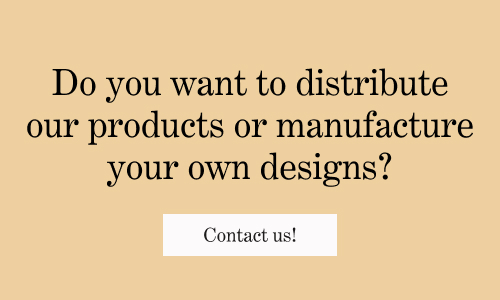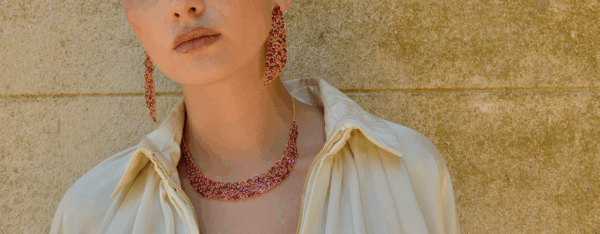Starting a jewelry business is much more than selling accessories: it’s entering a world where each piece tells a story, evokes emotion, and accompanies unique moments.
At Salvatore Plata, we have been working in the jewelry sector for over 30 years, designing, manufacturing, and distributing collections now sold in numerous countries worldwide. This experience has allowed us to understand the key factors for succeeding in this market, whether you are just starting out or are an established professional.
We can tell you that turning that passion into a profitable business is not just a matter of good taste. It requires planning, market knowledge, and, above all, an authentic and solid proposition.
That’s why we want to share all our knowledge with you in this guide, helping you understand how to analyze the market, define your audience, choose the style of your pieces, set prices, plan your sales channels, and build a brand with its own personality.
If you dream of opening your own jewelry store or online shop, this content is designed for you.
Why jewelry is such an attractive business
Jewelry is much more than a commercial sector; it’s a silent language of emotions. Jewelry celebrates achievements, accompanies special moments, is inherited, and becomes amulets. That’s why, even in times of crisis, the demand for quality jewelry remains stable or reinvents itself.
Moreover, today’s market offers enormous opportunities for those who know how to differentiate themselves. You can focus on:
- High jewelry with precious metals and gemstones.
- Fashion jewelry with accessible designs and variety.
- Handmade, personalized pieces that connect with a demanding audience.
Digitalization has opened the doors to online sales and internationalization, while social media has democratized promotion.
If you want to start a successful jewelry business, the first step is understanding this emotional value and building your business proposition around it. Below, we will guide you through all the steps to start a jewelry business while minimizing mistakes and risks.
How to start a jewelry business step by step
Step 1: Analyze the market and competition
Starting a jewelry business without studying the field is like designing blindfolded. Before investing money or launching your brand, you need to understand the market: what sells, at what price, who buys it, and who is already in the game. This step is essential to avoid costly improvisations and build a solid, differentiated proposal.Analyzing competitors is not about copying them; it’s about learning what works, what can be improved, or which gaps in the market are unfilled. It’s your opportunity to identify real opportunities and adapt your business idea to an audience that truly values it.
Analyzing the market allows you to:
- Identify trends: minimalist, vintage, gemstones, personalization.
- Discover untapped niches locally or online.
- Analyze average prices, quality, and sales channels.
Useful tools we recommend:
- Google Trends to track online jewelry searches.
- Social media to detect popular styles and brands.
- Physical stores and marketplaces to study prices and competition.
- Rely on experienced distributors like Salvatore Plata.
The goal is not to copy, but to learn from what already works to create your unique proposition.
Step 2: Know your potential clients
After understanding the general market, you need to refine further: who is your ideal client? Understanding your potential audience deeply is key to designing the right pieces, setting prices, and crafting a message that resonates. Not all jewelry suits everyone or every budget.Visualize your clientele: their tastes, lifestyle, and motivations for buying jewelry. Only then can you offer something that not only appeals but actually sells.
Questions to help you:
- What is the age of your potential clients?
- What is their lifestyle? Gift, daily wear, special events?
- What is their average budget?
- Where do they currently shop? Physical store or online?
Create a buyer persona with these details to focus your catalog and marketing strategy.
Step 3: Choose the type of jewelry business
Now that you know what to offer and to whom, decide how you will sell it. There is no single formula; each business model has advantages and challenges.Do you want a physical store to attract local clients? Or an online shop to reach all of Spain—or even the world—with lower investment? Or a hybrid approach combining a showroom or fairs with e-commerce flexibility? Making this decision carefully will help you plan investment, manage costs, and avoid surprises.
Common business models:
Business Model Pros Cons Physical store Personalized service; sensory experience; direct loyalty Higher initial investment; rent, licenses, and staff costs Online store Lower initial cost; wide geographic reach; open 24/7 Global competition; need for professional photography and logistics Hybrid model Showroom or pop-up + online sales; fairs/events to attract digital clients Need to coordinate both channels; higher logistical planning Choosing your sales channel wisely is essential for project viability.
Step 4: Define style and catalog
Your catalog is not just a collection of products; it’s the heart of your brand and the most direct way to communicate your value proposition. A clear, coherent style helps differentiate in a competitive market and allows clients to understand who you are and why they should choose you.Selling “everything” is tempting, but in jewelry, it usually dilutes identity. What attracts is a defined concept, carefully crafted, with its own personality. Reflect carefully on materials, finishes, and design so that your pieces align with your target audience.
Catalog options:
- Distribute established brands’ collections: ready-made, recognized styles, guaranteed quality.
- Create your own exclusive line: define your style, materials, and design from scratch. Higher planning effort, but total control and customization.
Questions to help define your catalog:
- What is your style? Classic, modern, boho, minimalist, gemstone?
- What materials will you use? Silver, gold, steel, natural stones?
- Will you sell custom pieces or pre-designed collections?
- Do you want variety or to specialize in a niche?
Your catalog is your business card. Dedicate time to make it reflect your vision.
Check Salvatore Plata’s catalog for styles, prices, and collaboration options.
Step 5: Plan prices, margins, and profitability
Creativity is essential, but bills don’t pay themselves. Calculate prices, margins, and profitability to ensure sustainability. Consider:
- Purchase or production costs
- Shipping and logistics
- Packaging
- Marketing and advertising
- Taxes and licenses
Recommended margins in jewelry range from 2.5x to 4x the cost, depending on segment and sales channel. For example, a €15 purchase price may require a minimum selling price of €45.
Never undervalue your product. Jewelry is design, quality, and experience. Investing in high quality ensures customer loyalty.
Step 6: Build your brand identity
A brand is not just a pretty logo; it’s how the world perceives you. In jewelry, this perception is everything. People buy not only for design or price, but for the story you tell, the promise of quality, and the trust you inspire.Key points:
- Memorable business name
- Consistent logo and color palette
- Storytelling behind your project
- High-quality product photography (manufacturers like Salvatore Plata provide professional photos and videos for distributors)
A strong brand conveys trust and justifies prices.
Step 7: Take care of legal and tax matters
A serious business must be legally compliant. This may seem uncreative, but it’s essential to avoid time, money, and reputation issues. Key points:
- Register as self-employed or establish a company
- Activity license (if physical store)
- VAT and tax obligations
- Contracts with suppliers
Professional legal or tax advice from the start is recommended.
Step 8: Make a marketing plan
A great product is useless if no one knows about it. Your marketing plan bridges your jewelry and clients, telling your story and showcasing your catalog. Key channels today:
- Website/online store
- Social media: Instagram, Pinterest, TikTok
- Marketplaces: Etsy, Amazon Handmade
- Digital ads: Meta Ads, Google Ads
- Events and collaborations: fairs, influencers, pop-ups
Create inspiring content, maintain aesthetics, and communicate consistently with sales objectives.
Step 9: Choose the right suppliers
Suppliers are strategic allies. Their quality, variety, and reliability largely determine your success. Consider:
- Material and finish quality
- Style variety for your audience
- Order flexibility
- Delivery times and reliability
- Clear commercial conditions
Salvatore Plata offers:
- Extensive catalog with styles and prices for different audiences
- Personalized advice to plan orders
- Established sales network in Spain and international distribution
- Real experience supporting new and established businesses
- 2-year warranty (with proper use)
- Certified sterling silver, safe and free of toxic/carcinogenic metals
- Updated catalog every six months
- Spanish company based in Valencia, supporting the local business ecosystem
Final inspiration and advice
Starting a jewelry business is exciting. It requires vision, planning, and passion, but above all, understanding that each piece you sell is more than a product—it’s part of someone’s story.
Tips:
- Don’t be afraid to stand out
- Stay updated with trends without losing your essence
- Take care of every detail: product, packaging, after-sales service
- Build long-term client relationships
- Surround yourself with partners and suppliers who share your vision
**Salvatore Plata supports







